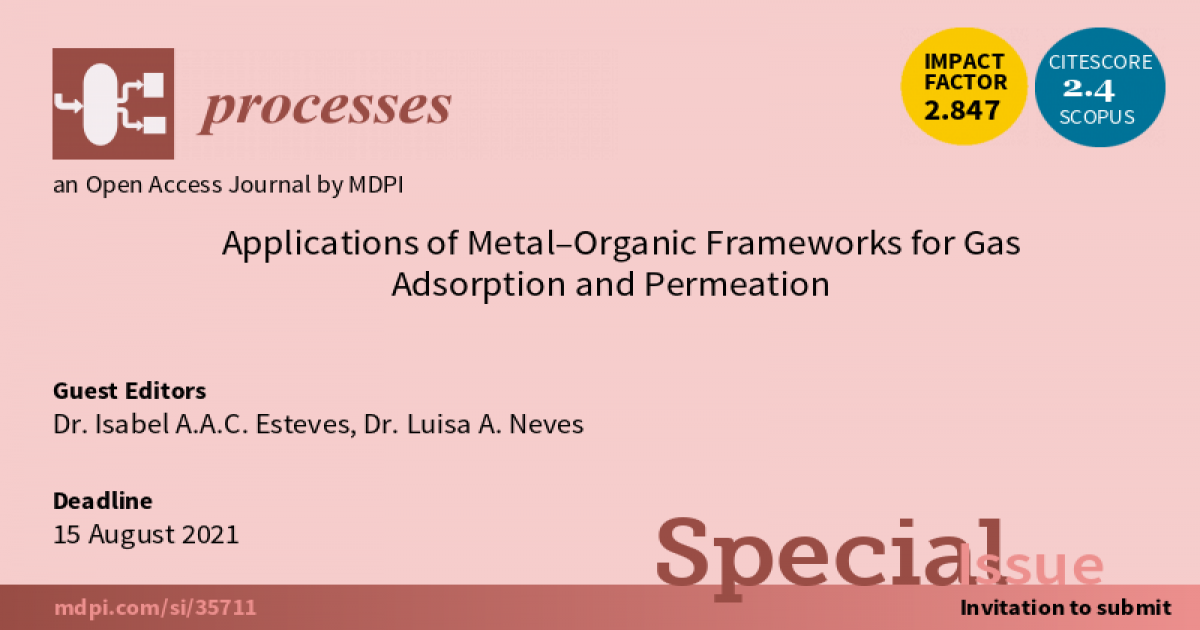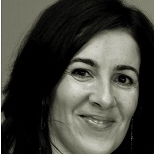Applications of Metal–Organic Frameworks for Gas Adsorption and Permeation
A special issue of Processes (ISSN 2227-9717). This special issue belongs to the section "Materials Processes".
Deadline for manuscript submissions: closed (15 August 2021) | Viewed by 6419

Special Issue Editors
Interests: gas adsorption processes; adsorbent materials; metal–organic frameworks; ionic liquids; gas separation; biomass to energy; biogas upgrading; carbon capture
Interests: mixed matrix membranes; ionic liquids; metal–organic frameworks; gas separation; biopolymeric structures; biomedical applications
Special Issues, Collections and Topics in MDPI journals
Special Issue Information
Dear Colleagues,
This Special Issue on “Applications of Metal–Organic Frameworks for Gas Adsorption and Permeation” is aimed at promoting research and progress in the field of metal–organic frameworks (MOFs) applied to gas separation, specifically in adsorption and membrane processes applications.
MOFs have gained their share on the advance of porous materials and their applications. The highly varying structural properties and chemical functionalities of MOFs, which can be tailored during their syntheses, have led to a panoply of derived materials. This opens prospects and challenges in the advancement of gas adsorption and task-specific gas membrane permeation applications, namely for carbon dioxide (CO2) and biogas-related separation technologies. Specifically, MOFs and their composite materials present unusual high CO2 selectivities which lead to high expectations in potential future developments of interest in separations, catalysis, and drug delivery.
This Special Issue will be focusing on:
- Fundamentals on design strategies, synthesis, characterization, and modeling;
- MOF-based adsorbents;
- MOF-based membranes;
- MOFs supporting ionic liquids (ILs@MOFs);
- Applications on gas separation.
An up-to-date picture of recent advances and breakthroughs in these areas, both fundamental, including modeling and experiments, and applied in the relevant technical fields, are most welcome either as original research papers, communication or as reviews.
Dr. Isabel A.A.C. Esteves
Dr. Luisa A. Neves
Guest Editors
Manuscript Submission Information
Manuscripts should be submitted online at www.mdpi.com by registering and logging in to this website. Once you are registered, click here to go to the submission form. Manuscripts can be submitted until the deadline. All submissions that pass pre-check are peer-reviewed. Accepted papers will be published continuously in the journal (as soon as accepted) and will be listed together on the special issue website. Research articles, review articles as well as short communications are invited. For planned papers, a title and short abstract (about 100 words) can be sent to the Editorial Office for announcement on this website.
Submitted manuscripts should not have been published previously, nor be under consideration for publication elsewhere (except conference proceedings papers). All manuscripts are thoroughly refereed through a single-blind peer-review process. A guide for authors and other relevant information for submission of manuscripts is available on the Instructions for Authors page. Processes is an international peer-reviewed open access monthly journal published by MDPI.
Please visit the Instructions for Authors page before submitting a manuscript. The Article Processing Charge (APC) for publication in this open access journal is 2400 CHF (Swiss Francs). Submitted papers should be well formatted and use good English. Authors may use MDPI's English editing service prior to publication or during author revisions.
Keywords
- metal–organic frameworks
- adsorption
- membrane permeation
- gas separation
Benefits of Publishing in a Special Issue
- Ease of navigation: Grouping papers by topic helps scholars navigate broad scope journals more efficiently.
- Greater discoverability: Special Issues support the reach and impact of scientific research. Articles in Special Issues are more discoverable and cited more frequently.
- Expansion of research network: Special Issues facilitate connections among authors, fostering scientific collaborations.
- External promotion: Articles in Special Issues are often promoted through the journal's social media, increasing their visibility.
- e-Book format: Special Issues with more than 10 articles can be published as dedicated e-books, ensuring wide and rapid dissemination.
Further information on MDPI's Special Issue polices can be found here.






